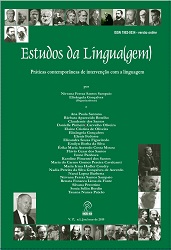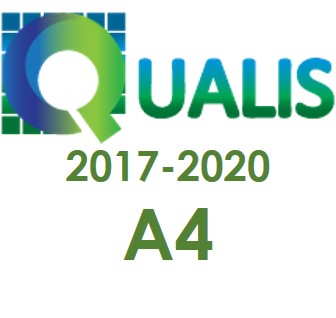Interdisciplinary group of coexistence: an intervention in health based on the discursive neurolinguistics
DOI:
https://doi.org/10.22481/el.v17i1.5296Keywords:
Language; Intervention; Neurolinguistics; Aphasia.Abstract
This paper aims to present the activities developed by the Interdisciplinar Group of Coexistence of the Department of Speech Pathology at the Federal University of Santa Maria, Rio Grande do Sul, Brazil. The theoretical-methodological approach considers the language as a constitutive activity of the subject which is actualized in the social interactions. The dialogical exchanges (verbal and non verbal ones) produced by the aphasic subjects contribute, on the one hand, to the recovering and/or the minimization for neurologic symptoms, instigate the social coexistence and act, mainly, in their self-esteem and their protagonism, as well as in their relatives’. On the other hand, the dialogical exchanges contribute to a differentiated formation of health professionals, with a comprehensive view of the language and the subject.
Downloads
References
BRASIL. Ministério da Saúde. Diretrizes de atenção à reabilitação da pessoa com acidente vascular cerebral. Brasília, 2013.
COUDRY, M. I. H. A linguagem em funcionamento na afasia. Letras de Hoje, Porto Alegre, v. 36, n. 3, p. 449-455, 2001.
______. Dez anos de Neurolinguística no IEL. Cadernos de Estudos Linguísticos, Campinas, n. 32, p. 9-23, 1997.
______. Diário de Narciso: Discurso e Afasia. Análise de interlocuções com afásicos. São Paulo: Martins Fontes, 1988-2001.
______. Neurolinguística Discursiva: afasia como tradução. Estudos da Lingua(gem), Vitória da Conquista, v. 6, n. 2, p.7-36, 2008.
FEDOSSE, E. Da relação linguagem e praxia: estudo neurolingüístico de um caso de afasia. 2000. Dissertação (Mestrado em Linguística) – Instituto de Estudos da Linguagem, Universidade Estadual em Campinas, Campinas, 2000.
______. Processos Alternativos De Significação De Um Poeta Afásico. 2008. 192 f. Tese (Doutorado em Linguística) – Instituto de Estudos da Linguagem, Universidade Estadual em Campinas, Campinas, 2008.
FRANCHI, C. Hipóteses para uma Teoria Funcional da Linguagem. 1975. Tese (Doutorado em Linguística) – Instituto de Estudos da Linguagem, Universidade Estadual em Campinas, Campinas, 1975.
MAINGUENEAU, D. Análise de textos de comunicação. São Paulo: Cortez, 2002.
MORATO, E. M.; et al. Sobre as afasias e os afásicos - teóricos e práticos elaborados pelo Centro de Convivência de Afásicos (Universidade Estadual de Campinas). Campinas: Unicamp, 2002.
NOVAES-PINTO, R. C. Cérebro, linguagem e funcionamento cognitivo na perspectiva sócio-histórico-cultural: inferências a partir do estudo das afasias. Letras de Hoje, Porto Alegre, v. 47, n. 1, p. 55-64, 2012.
PANHOCA, I; GONÇALVEZ, C. A. B. Afasia e qualidade de vida – consequências de um acidente vascular cerebral na perspectiva da fonoaudiologia. Arq. Ciênc. Saúde UNIPAR, Umuarama, v. 13, n. 2, p. 147-153, maio/ago, 2009.
SAMPAIO, N. F. S. Uma abordagem sociolinguística da afasia: o Centro de Convivência de Afásicos (Unicamp) como uma Comunidade de Fala em Foco. 2006. 175 f. Tese (Doutorado em Linguística) – Instituto de Estudos da Linguagem, Universidade Estadual de Campinas, Campinas, 2006.
_______. Um enfoque etnolingüístico da afasia: o Centro de Convivência de Afásicos (UNICAMP) como uma comunidade de Fala. Sínteses – Revista dos Cursos de Pós-Graduação, v. 12, p. 271-279, 2007.
VILELA E. M.; MENDES, I. J. M. Interdisciplinaridade e saúde: estudo bibliográfico. Revista Latino-Americana em Enfermagem, v. 11, n. 4, p. 525-531, jul.-ago. 2003.
VYGOTSKY, L. S. Pensamento e Linguagem. São Paulo: Martins Fontes, 1987-1991.
YONG-KYU, C; CHAN-WOO, N; JUNG-HO, L; YOUNG-HAN, P. The Effects of Taping Prior to PNF Treatment on Lower Extremity Proprioception of Hemiplegic Patients. Journal of Physical Therapy Science, v. 25, p. 1119–1122, 201
Downloads
Published
How to Cite
Issue
Section
License

Estudos da Língua(gem) is licensed under a Creative Commons Attribution 4.0 International License.
Authors who publish in the journal Estudos da Língua (gem) agree with the following terms:
The journal Estudos de Língua(gem) maintains the copyrights of the contributions published. These rights include the publication of the contribution and make its content available for free through the portal.







